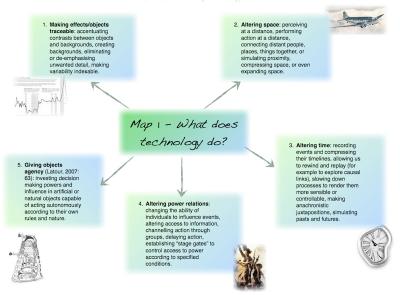What is a learning ecology?
 The concept of learning ecology helps us to go beyond a simplistic, gadget-oriented view of technology. We need to understand technologies as embedded within the habitual lived experience of learners and their communities, looking beyond the hype and the showcased innovation experiment. John Seeley Brown, introduced the idea in his influential article from 2000 on "Growing Up Digital: How the Web Changes Work, Education, and the Ways People Learn" 1. Seeley used it to show how new technologies encourage new niches and habitats, requiring new collective and individual behaviours. But it is also a broader concept, appplying equally well to a world without digital technology, or to one with an unevenly distributed access to innovation (for other interesting precedents, see Gregory Bateson's Steps to an Ecology of Mind2, Felix Guattari's The Three Ecologies3, and Eleanor Gibson's An Ecological Approach to Perceptual Learning and Development4).
The concept of learning ecology helps us to go beyond a simplistic, gadget-oriented view of technology. We need to understand technologies as embedded within the habitual lived experience of learners and their communities, looking beyond the hype and the showcased innovation experiment. John Seeley Brown, introduced the idea in his influential article from 2000 on "Growing Up Digital: How the Web Changes Work, Education, and the Ways People Learn" 1. Seeley used it to show how new technologies encourage new niches and habitats, requiring new collective and individual behaviours. But it is also a broader concept, appplying equally well to a world without digital technology, or to one with an unevenly distributed access to innovation (for other interesting precedents, see Gregory Bateson's Steps to an Ecology of Mind2, Felix Guattari's The Three Ecologies3, and Eleanor Gibson's An Ecological Approach to Perceptual Learning and Development4).
An ecology, in the conventional sense, is:
- a habitat in which individuals of various species co-exist in relative stability and inter-dependence;
- a set of overlapping but distinct territories and niches, each with its own rules, affordances and constraints;
- a self-regulating system that consumes and recycles resources;
- an organisation in which change occurs over time, modifying individuals, species and inter-relations, without destroying the overall cohesion and balance.
All of these things are also true of a learning ecology, but with a massively important addition: cognitive reflexivity. The learning ecology collectively and individually thinks about itself and its habits. Individuals represent themselves and the ecology (as they see it). They actively create, modify and destroy territories and niches (learning spaces in every sense). They arrange instruments for monitoring and assessing. They create targets and cyclic patterns (for example, the three year undergraduate degree). They have doubts, fears, and sometimes paranoias. They are unsatisfied and curious. They contend, create, experiment, choose, and self-modify. Sometimes they get too far from equilibrium. Sometimes they are too close to equilibrium.
The technologies and practices that underpin these processes are essential for its success, and a principal object of its concern. However, most of the time we have very little consciousness of how learning ecologies function - especially how our students function within this wider context. For example, a single session might see students arive with a wide range of habitual practices. For some, recording events using a mobile phone directly into Facebook might be the ordinary means by which they record and socially consider the value of an experience. Other students might carefully and restrictively manage their personal presence online, only to find that Facebook disrupts their control. Some student might arive with a mature understanding of information, permissions, access controlled web zones and the necessary ettiquete. Others might not. And all of the time new technologies and practices are coming along to complicate matters further, not simply within the habitat of the classroom or workshop, but within the wider whole-campus ecology and beyond. Often we make the mistake of thinking that the students in a workshop are a relatively uniform species, with uniform habits matching the habitat that we have created. In fact they are more often like nomads together for a rare meeting-up of the tribes (with all of the tensions and excitements that implies). Trends towards more complex study patterns, part-time employment, distance or blended study, widening participation, and the virtualisation of culture are making this ever more "interesting".
The diagram below illustrates some of the powerful effects that digital technologies can have upon learning ecologies. Use this as a tool to analyse technologies, and as a way to think of how you might alter a learning ecology using technology. Think about how a technology (and your use of it) affords and constrains the manipulation of information, space, time, power and agency. For example, the techniques described in the Live Archiving case study can support us in recording and tracing transitions in understanding and emotion during a session. By capturing ideas and feelings immediately into a timeline-organised notebook, we can trace changes that might otherwise be lost in the moment. The Telepresent Tehran case study is a clear-cut example of "altering space", bringing people, knowledge and experience across otherwise impenetrable boundaries. As with many OSL based practices, the participatory non-hierarchical approach to Designing a Learning Ecology alters power relations, with two students becoming the directors of a movie that narrates an alternative way of learning. And as Carol Rutter and Jon Trenchard discovered, video editing can itself be a way of experimentally rewinding, replaying and rethinking an event after it has happened - by Unpinning Video Editing we unpin time and causality. Finally, and most astonishingly, Theatre Studies undergraduates Catherine Allen (now Managing Director of Ember Television) and Lauren Cameron designed an OSL style event that we developed into the idea of Theory Roulette, an immersive open-space experience that combines all five effects.
Click the image to view it full size.
For example, consider a common key action necessary for success in undergraduate learning:
Using feedback to improve: The student receives feedback on a piece of assessed written work, from the marker, as text within a hand written feedback sheet. They read and interpret the feedback. They show the feedback sheet to their friends. They seek further clarification of the feedback by emailing their seminar tutor, so as to understand it more effectively. They plan actions based upon the feedback. They implement those actions before and during the completion of their next assignment. Their next assignment improves as a consequence.
This process is mediated, unthinkingly, by habitual practices and technologies. It could be mediated more efficiently. The feedback text could be provided in an electronic format, with links to a glossary to explain some of the less obvious terminology. This might have an unforeseen effect on other aspects of the "ecology". One could realistically concieve that the terms in the glossary start to feed-forwards into the way in which future essays are written; and then that could feed-backwards by encouraging teachers to set assignments that fit with these well-understood and safe terms of reference. A key feature of the ecology changes.
Alternatively, we could introduce quite a different approach - for example, an Open-space Learning approach might work as follows:
Using feedback to improve (using OSL): The student receives their feedback as a storyboard that models the structure of their essay and how it went wrong (or how the marker perceives it). In small groups, they consider the structure and how it might be rearranged. They practice and present the new narrative, recording it on paper. They use this new narrative when planning their next assignment.
This might be optimised further using technology. They could (re)model their storyboard/essay-structure using a visualisation tool on an iPad during the OSL session. This could then be saved into their own personal storage space. They might continue to revise and develop their model after the OSL session. They could even show this to a tutor and get further feedback and advice. Again the learning ecology has changed.
Next, we need to put this into practice using a systematic and creative methodology...
1 John Seeley Brown, "Growing Up Digital: How the Web Changes Work, Education, and the Ways People Learn" in Change, March/April 2000, p 10-20.
2 Bateson, Gregory, Steps to an Ecology of Mind: Collected Essays in Anthropology, Psychiatry, Evolution, and Epistemology. University Of Chicago Press, 1972.
3 Felix Guattari, The Three Ecologies, Trans. Ian Pindar & Paul Sutton, London & New Brunwick, NJ: The Athlone Press, 2000.
4 Eleanor Jack Gibson, Anne D. Pick, An Ecological Approach to Perceptual Learning and Development, OUP, 2000.

